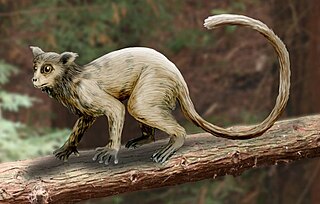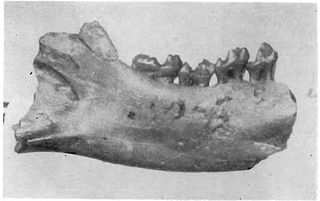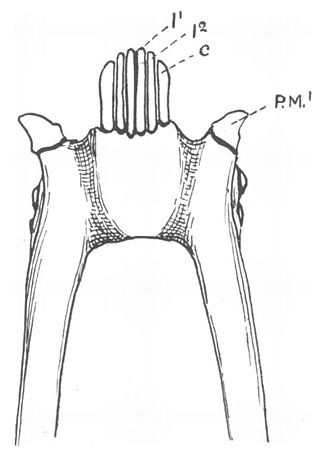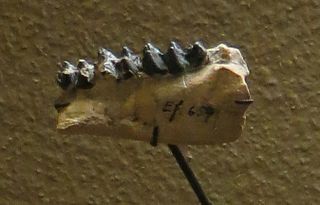
Omomyidae is a group of early primates that radiated during the Eocene epoch between about 55 to 34 million years ago (mya). Fossil omomyids are found in North America, Europe & Asia making it one of two groups of Eocene primates with a geographic distribution spanning holarctic continents, the other being the adapids. Early representatives of the Omomyidae and Adapidae appear suddenly at the beginning of the Eocene in North America, Europe, and Asia, and are the earliest known crown primates.

Propalaeotherium was an early genus of perissodactyl endemic to Europe and Asia during the early Eocene. There are currently six recognised species within the genus, with P. isselanum as the type species.

Plesiadapis is one of the oldest known primate-like mammal genera which existed about 58–55 million years ago in North America and Europe. Plesiadapis means "near-Adapis", which is a reference to the adapiform primate of the Eocene period, Adapis. Plesiadapis tricuspidens, the type specimen, is named after the three cusps present on its upper incisors.

Necrolemur is a small bodied omomyid with body mass estimations ranging from 114 grams to 346 grams. Necrolemur’s teeth feature broad basins and blunt cusps, suggesting their diet consisted of mostly soft fruit, though examination of microwear patterns suggests that populations from lower latitudes also consumed insects and gums. While they do not sport a true tooth comb like modern lemurs, microwear patterns on their lower incisors suggest they engaged in fur grooming behaviors. Like tarsiers, Necrolemur had large, front-facing, close set eyes and were likely nocturnal. Analysis of cranial and postcranial fossils by paleontologists suggest members of the family Omomyidae, including the genus Necrolemur, possessed highly specialized adaptations for leaping.

Altanius is a genus of extinct primates found in the early Eocene of Mongolia. Though its phylogenetic relationship is questionable, many have placed it as either a primitive omomyid or as a member of the sister group to both adapoids and omomyids. The genus is represented by one species, Altanius orlovi, estimated to weigh about 10–30g from relatively well-known and complete dental and facial characteristics.

Pelycodus is an extinct genus of adapiform primate that lived during the early Eocene (Wasatchian) period in Europe and North America, particularly Wyoming and New Mexico. It is very closely related to Cantius and may even be its subgenus. It may also have given rise to the Middle Eocene Uintan primate Hesperolemur, although this is controversial. From mass estimates based on the first molar, the two species, P. jarrovii and P. danielsae, weighed 4.5 kg and 6.3 kg respectively and were frugivores with an arboreal, quadrupedal locomotion.

A toothcomb is a dental structure found in some mammals, comprising a group of front teeth arranged in a manner that facilitates grooming, similar to a hair comb. The toothcomb occurs in lemuriform primates, treeshrews, colugos, hyraxes, and some African antelopes. The structures evolved independently in different types of mammals through convergent evolution and varies both in dental composition and structure. In most mammals the comb is formed by a group of teeth with fine spaces between them. The toothcombs in most mammals include incisors only, while in lemuriform primates they include incisors and canine teeth that tilt forward at the front of the lower jaw, followed by a canine-shaped first premolar. The toothcombs of colugos and hyraxes take a different form with the individual incisors being serrated, providing multiple tines per tooth.
Altiatlasius is an extinct genus of mammal, which may have been the oldest known primate, dating to the Late Paleocene from Morocco. The only species, Altiatlasius koulchii, was described in 1990.

Europolemur is a genus of adapiform primates that lived in Europe during the middle Eocene.
Algeripithecus is an extinct genus of early fossil primate, weighing approximately 65 to 85 grams. Fossils have been found in Algeria dating from 50 to 46 million years ago.
Duerotherium is an extinct genus of Paleogene artiodactyls known only from the Iberian Peninsula during the Middle Eocene, which contains one species D. sudrei. It, like other members of the Anoplotheriidae, was endemic to western Europe. The anoplotheriine was described from a left fragment of a maxilla from the Mazaterón Formation of the Duero Basin in 2009. Its dentition is mostly typical of the Anoplotheriinae but differs by an elongated plus triangular 3rd upper premolar and very specific traits of the molars. It is thought to have been part of an endemic faunal assemblage that evolved within the Iberian Peninsula by the Middle Eocene, where climates were subtropical.
Azibiidae is an extinct family of fossil primate from the late early or early middle Eocene from the Glib Zegdou Formation in the Gour Lazib area of Algeria. They are thought to be related to the living toothcombed primates, the lemurs and lorisoids, although paleoanthropologists such as Marc Godinot have argued that they may be early simians. It includes the genera Azibius and Algeripithecus, the latter of which was originally considered the oldest known simian, not a strepsirrhine.
Azibius is an extinct genus of fossil primate from the late early or early middle Eocene from the Glib Zegdou Formation in the Gour Lazib area of Algeria. They are thought to be related to the living toothcombed primates, the lemurs and lorisoids, although paleoanthropologists such as Marc Godinot have argued that they may be early simians. Originally described as a type of plesiadapiform, its fragmentary remains have been interpreted as a hyopsodontid, an adapid, and a macroscelidid. Less fragmentary remains discovered between 2003 and 2009 demonstrated a close relationship between Azibius and Algeripithecus, a fossil primate once thought to be the oldest known simian. Descriptions of the talus in 2011 have helped to strengthen support for the strepsirrhine status of Azibius and Algeripithecus, which would indicate that the evolutionary history of lemurs and their kin is rooted in Africa.
Djebelemur is an extinct genus of early strepsirrhine primate from the late early or early middle Eocene period from the Chambi locality in Tunisia. Although they probably lacked a toothcomb, a specialized dental structure found in living lemuriforms, they are thought to be a related stem group. The one recognized species, Djebelemur martinezi, was very small, approximately 100 g (3.5 oz).
Plesiopithecus is an extinct genus of early strepsirrhine primate from the late Eocene.
Sivaladapis is a genus of adapiform primate that lived in Asia during the middle Miocene.

Achaenodon is an extinct artiodactyl mammal, possibly belonging to the family Helohyidae. It lived in the mid-late Eocene and its fossil remains have been found in North America.
Jens Lorenz Franzen was a German paleontologist. He was the head of Paleoanthropology and Quaternary at Naturmuseum Senckenberg in Frankfurt and participated in fossil excavation in Germany. He worked with scientific excavations and discovered many previously unknown fossil mammal species.

Catodontherium is an extinct genus of Paleogene artiodactyls belonging to the family Anoplotheriidae. It was endemic to western Europe and had a temporal range exclusive to the middle Eocene, although its earliest appearance depends on whether C. argentonicum is truly a species of Catodontherium. It was first named Catodus by the French palaeontologist Charles Depéret in 1906, who created two species for the genus and later change the genus name to Catodontherium in 1908. The Swiss palaeontologist Hans Georg Stehlin renamed one species and classified two other newly erected species to Catodontherium in 1910. Today, there are four known species, although two remain questionable in genus placement.
Robiatherium is an extinct genus of Paleogene artiodactyls containing one species R. cournovense. The genus name derives from the locality of Robiac in France where some of its fossil were described plus the Greek θήρ/therium meaning "beast" or "wild animal." It was known only from the middle Eocene and, like other anoplotheriids, was endemic to western Europe. The genus was erected by Jean Sudre in 1988 for a species originally attributed to the xiphodont genus Paraxiphodon in 1978. Robiatherium had dentitions typical of the subfamily Anoplotheriinae, differing from other genera by specific differences in the molars. It is one of the earliest-appearing anoplotheriine species in the fossil record as well as the earliest to have appeared in central Europe.










